| 1 | Spotted harlequin snake |
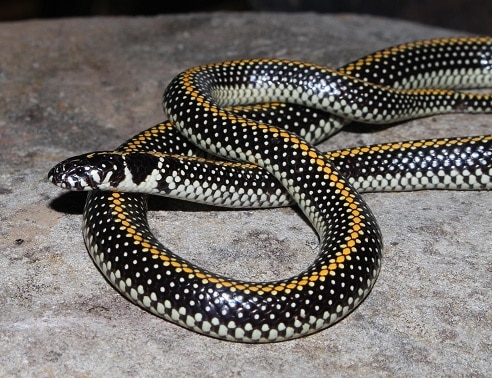
The spotted harlequin snake is an impossible species to miss in the African savannah. This funky species is mildly venomous, and mainly a harmless neighbor of human beings (plus zebras, giraffes, antelopes, etc). They’re found across a large swathe of South Africa, but no other country except the tiny Lesotho and Eswatini. Reptiles are their primary prey, including legless skinks, other snakes and small lizards.
Spotted harlequin snakes (Homoroselaps lacteus) are a shy species, which spend their lives lurking under old termite mounds or rock piles. They occasionally appear near buildings under rubble and debris as well. With an average length of 40-50cm (maximum 65cm), they’re highly effectively at staying hidden. Their dazzling colours are actually a survival strategy, as if they are uncovered, they use these to shock predators, which assume that they’re venomous based on their resemblance to lethal coral snakes.
Spotted harlequin snakes can be very common in parts of South Africa, even if they rarely come out into the open. While always bright and colourful, the precise pattern varies strongly by region.
Their venom is relatively mild, causing swelling and minor necrotic lesions. At the most extreme, its venom can dissolve the membranes of capillaries, causing minor blood vessel leakage, but only 7 bites have officially been recorded in the last 70 years. Rather than biting, spotted harlequin snakes prefer to wrestle furiously if picked up.
| 2 | Bibron’s stiletto snake |
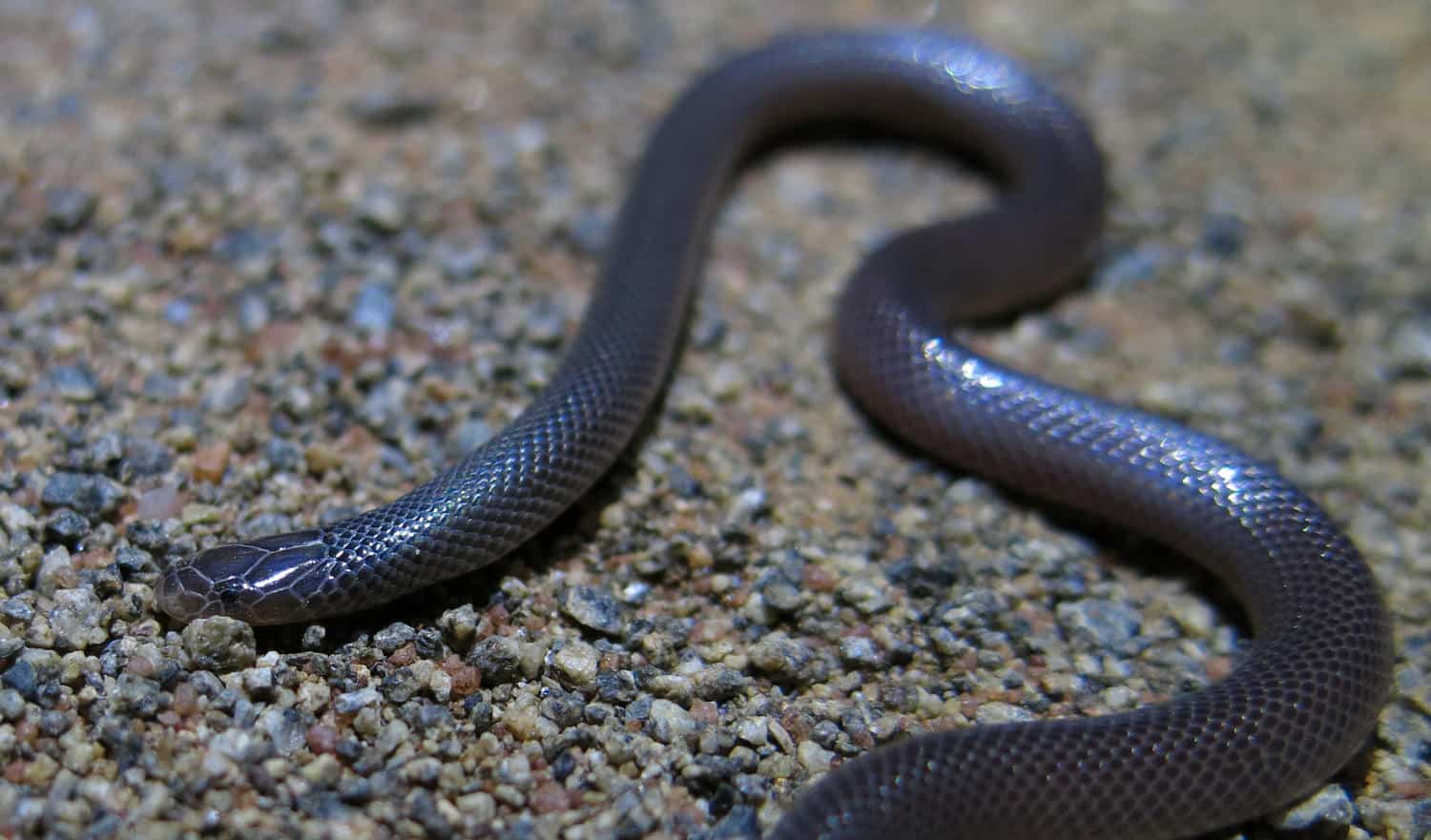
Perhaps the sneakiest dangerous snake in South Africa. Bibron’s stiletto snake (Atractaspis bibronii) is infamous for its weird fang formation, with a singular fang that juts sideways out of the mouth, allowing them to swipe at victims even when their mouth is fully closed. Bibron’s stiletto snake reaches a maximum of 70cm, and is responsible for a large chunk of South African snakebites, along with the cape cobra.
This species is mainly an underground snake, burrowing in surface layers and emerging after heavy rains. With oily black scales, and virtually no patterns, Bibron’s stiletto snakes look very similar to harmless underground blind snakes. There’s no iconic neck flare to alert people as with a cobra, and this is why they’re so risky. A large proportion of South Africans are bitten while carrying this snake away from gardens, mistaking it for harmless species.
Making matters worse, Bibron’s stiletto snake is relaxed about biting, and will do so if they feel even the slightest concern. All it takes is for an animal larger than them to get within touching distance. Unlike a coral snake or honeybee, stiletto snakes don’t need to be harassed constantly to attack. Their venom is moderately dangerous, delivering intense pain, swelling and possible necrosis. One patient suffered an amputated fingertip, and other symptoms include hoarseness, painful eyes when moved, headaches, and a dry mouth.
The saving grace is that the venom arrives in small quantities, like the boomslang. On the other hand, their fangs are unusually long, hence the stiletto name, which references the stiletto daggers wielded by assassins. Bibron’s stiletto snakes also have a spiky tail, and if you’re lucky, they’ll choose this weapon instead of their fangs.
| 3 | Cape sand snake |
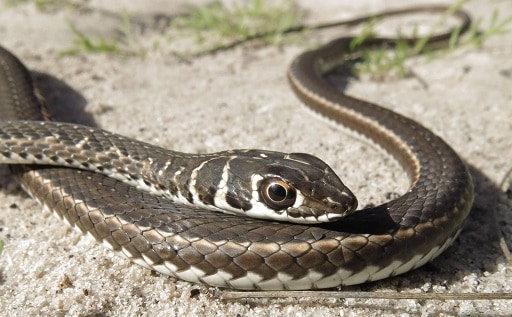
One of South Africa’s faster, whippier snakes. The cape sand snake is mildly venomous, and is found in most of South Africa (except the northeast), plus Namibia and Botswana. This is a thin, twig-like species which could never knock over a gazelle in a single brutish lunge like the African rock python. Instead, cape sand snakes have the gift of speed and agility, allowing them to slip through your fingers as you try to grab them for a photo op.
Cape sand snakes have a mild venom secreted from their rear fangs, but are no threat to human beings. They’re part of the large 33-member Psammophis genus, and have the usual pattern layout. Rather than encircling bands, cape sand snakes have parallel brown-black stripes stretching down their entire body. They have a particularly long tail, which only adds to their agility.
Cape sand snakes average at 50-80cm, yet the ones who’ve had the most success grabbing lizards over their lives can balloon to just over 100cm. They’re common in sandy areas along coastlines, and especially areas heavy in dry shrubs, which they often take shelter beneath. They’re a daytime hunter, and like the black mamba, they have the power to speed forward freakishly with the upper third of their bodies raised off the ground.
| 4 | Eastern tiger snake |
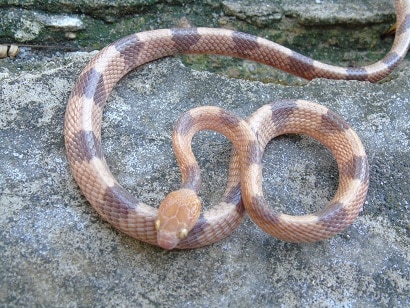
A slightly venomous, but almost completely harmless snake. This 75cm species (max 105cm) has no relation to the feared tiger snakes of Australia. Instead, they’re named for their striking pattern of black bands on orange scales.
Eastern tiger snakes, AKA common tiger snakes, are found in a variety of habitats, ranging from spacious forests and savannah to rocky plains and shrubland. They’re excellent tree climbers, and often wedge themselves beneath strips of bark and rest there in perpetuity. They have a diverse diet, focussing on lizards but supplementing with small mammals and nestling birds. They’re said to swallow geckos happily in captivity.
Though harmless, eastern tiger snakes (Telescopus semiannulatus) can be intimidating to newbies. They flare their necks wildly, gape open their mouths with an insane expression, and leap forward to deliver a thudding bash. Fortunately, all this is just an elaborate ruse.
For normal people, eastern tiger snakes are most commonly spotted while crossing roads. The patterns and bulging eyes make them one of the easiest IDs for an amateur, allowing you to wow your friends with your knowledge while on safari, making yourself seem like a renaissance man who’s an expert on all things. South Africa is also home to the karoo tiger snake, but this species lives in the west, while common tiger snakes cover the centre and east of the country.
| 5 | Red-lipped snake |
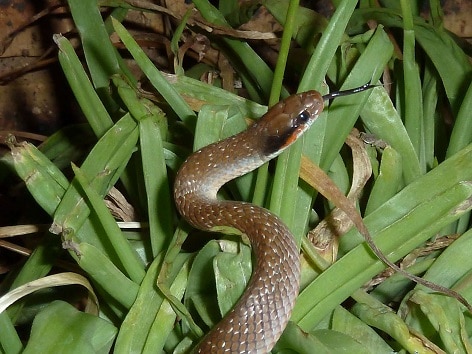
This 70cm species is simple to identify even before the namesake red lip. The red-lipped snake (Crotaphopeltis hotamboeia) has a dark olive body, sprinkled with white dots that contrast sharply. They have an oily black tongue, combined with extremely black eyes. Their red lip contrasts sharply against a jet black patch just behind their eye.
Red-lipped snakes are relatively common, appearing across a huge swathe of South Africa, though they skip the dry northwest. Compared to most South African snakes, they’re much more attracted to moisture. Their habitats therefore include marshland, moist savannahs, forests, lush grassland, and even suburban back gardens.
Their diet is also a moist one, as red-lipped snakes are an amphibian specialist. Rain frogs are a particular favourite, and they have the power to swallow unusually large toads.
If you see this snake heading directly towards you, seconds from pouncing range, there’s little to fear. They have a mild venom which barely affects humans, and their fangs aren’t especially vicious. However, they have an intimidating defensive display, where they draw their head back into striking position as though preparing to unleash imminent death. The largest ever red-lipped snake was a male measuring 89.1cm.
| 6 | Western natal green snake |
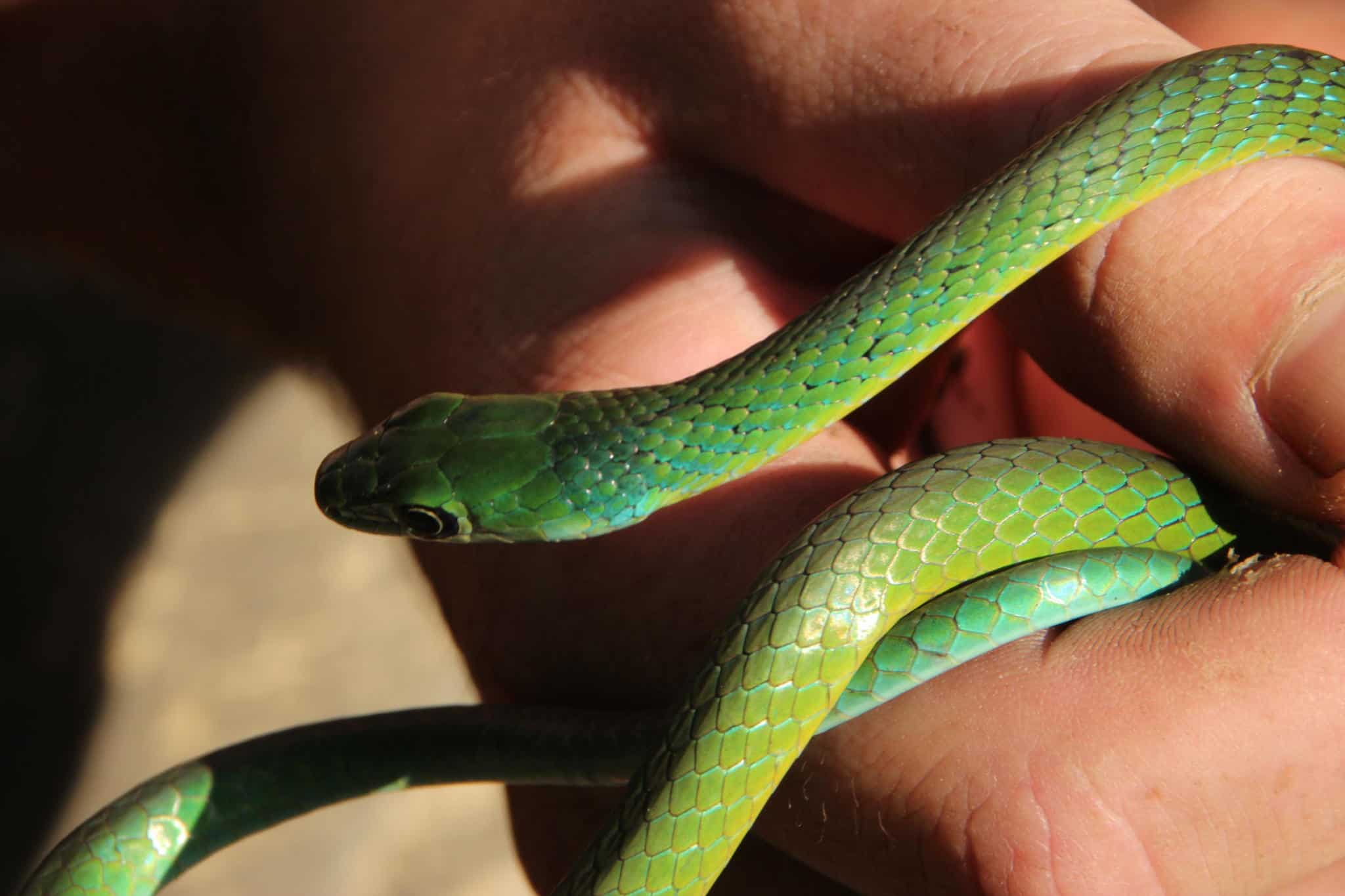
A common species along the coasts of South Africa, especially the southern and eastern coasts. The western natal green snake (Philothamnus occidentalis) is only slightly venomous, and reaches a maximum of 130cm. This is an extremely green snake which appears only in moister areas of South Africa, especially ponds smothered by reeds and knee length grass. Their camouflage is supreme, and it’s very tricky to see them when they rest motionless in long grass.
Western natal green snakes are strong swimmers, but mostly stick to the water’s edge, along streams and ponds, where they like to climb into low branches. Instead of fleeing, they use one of the most time-tested survival strategies of the animal kingdom: blending into thick greenery. As long as green foliage grows, there’ll always be an ecological niche for an ultra green snake to appear, and this is South Africa’s version.
Up close, the greenness gets more complex, as almost fluorescent patches appear. There are also black cracks visible between each scale. Western natal green snakes have very large eyes, which are purely black, with a round pupil. They’re quite similar to boomslangs in appearance, and are often killed by locals in fear, despite being completely harmless.
Being so green, it’s unlikely that you’d spot a western green natal snake from a safari vehicle. It you did, it would probably drive straight into a pond afterwards.
| 7 | Cape reed snake |
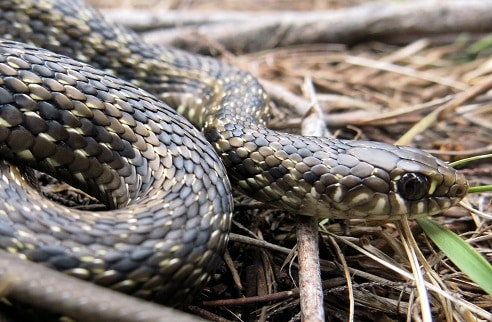
This moderately venomous species is found only in the southern reaches of the African continent, including South Africa, and small areas of Mozambique and Zimbabwe. They’re an isolated snake on the evolutionary tree, as they’re the only member of the Amplorhinus genus, with no close connections to other living snakes.
Many-spotted reed snakes (Amplorhinus multimaculatus) are found in moist environments, rather than parched deserts or rockland. Their favourites are riverine vegetation and reed beds, while grasslands and fynbos are also acceptable. Though not truly dangerous, a bite from Amplorhinus multimaculatus could still ruin your day with a nasty bout of swelling. Their first move when cornered is to coil into a tight spring to persuade people to leave. It goes without saying that this almost always works, except maybe for drunken teenagers out on a dare.
Many-spotted reed snakes measure 63cm at the most. They have subtle colours, featuring blackish to almost honey brown scales, interspersed with small white dots. This species can be hard to find – they’re common where they live, yet are secretive, and don’t pop up for photo opportunities on request.
| 8 | Fisk’s house snake |
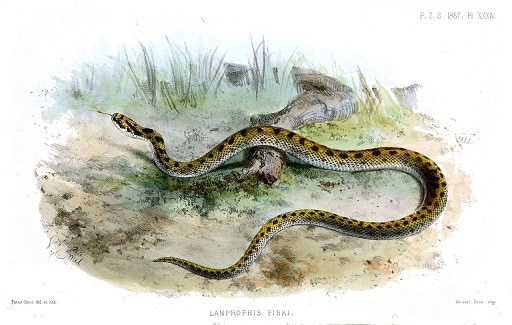
This non-venomous, diminutive species lives in South Africa’s western regions, perhaps crossing into extreme southern Namibia. Fisk’s house snake (Lamprophis fiskii) is hardly ever seen by humans – hence why we only have an explorer’s sketch for the image. They were first unearthed in 1887, and in 1982, a pair were found near Springbok, the first discovery in nearly a century, although local villagers had probably seen it over the years and not realised the significance.
Little is known of Fisk’s house snake, but a lizard was found in one individual’s stomach. A few have been raised in captivity, and they mostly ate geckos. Most sightings nowadays are on lonely dirt roads.
Their small size of 25-35cm (maximum 40cm) also allows them to easily dodge humanity’s roving vision. On the other hand, Fisk’s house snake is one of South Africa’s more colourful species, with orange and black colours contrasting like a totem pole, and finer matrix patterns on their flanks. In fact, this species looks more like a tiger than the eastern tiger snake.
| 9 | Berg adder |
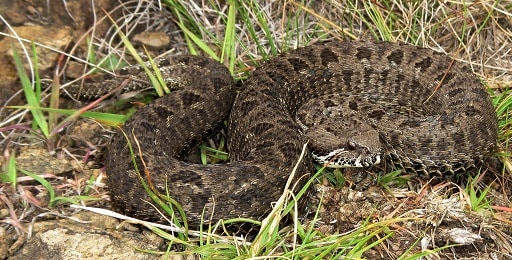
A small but dangerous viper, which averages at 30-40cm, with a maximum so far of 60cm. This is a high altitude viper, rarely appearing below 1500 metres and sometimes reaching heights of 3000m. Berg adders (Bitis atropos) favour cool areas of South Africa with high precipitation. They’re the opposite of cobras in their lifestyle, as instead of manic and energetic, they prefer to wait patiently in the undergrowth, barely moving and with a constant menacing expression.
Berg adders sometimes adjust their position while waiting, finding new grass strands to nestle in, but they’re an inactive ambush snake on the whole. This is exactly why they’re so dangerous. Berg adders are very easy to step on, with only wise village elders having the experience to walk through the serpent minefield unscathed. On the other hand, berg adders also enjoy basking in the sun, which brings them to more exposed mountain paths and rocky ridges.
Berg adders have a mainly neurotoxic venom. Victims experience disrupted nervous system signals, and may end up on a ventilator as their lungs become incapable of sucking in enough oxygen unaided. No antivenom is available, but fortunately, there are no confirmed deaths either. Berg adders can be violent and vicious if disturbed. They may be lazy, but they’re not cowardly.
| 10 | Olive snake |
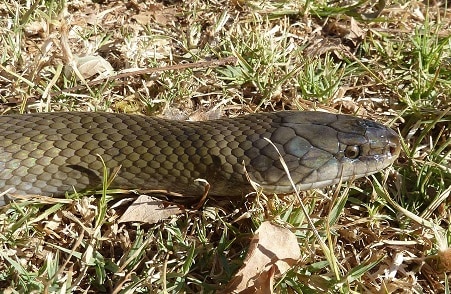
A harmless, lazy species. The olive snake takes no sides in South Africa’s various conflicts, whether it’s park rangers versus poachers or cape cobras versus mongooses. They’re a humble snake which is simply trying to survive, hoping to keep quiet so that blundering predators don’t notice them.
Olive snakes (Lycodonomorphus inornatus) are nocturnal, and average at 30-60cm, with a maximum of 130cm. They’re mainly concentrated along the southern and eastern coasts of South Africa, including within the city of Cape Town. The only other countries they inhabit are Lesotho and Eswatini (formerly known as Swaziland). While not a water snake, olive snakes prefer areas with higher moisture such as fynbos, grassland and bushland, rather than savannahs.
Olive snakes are indeed mostly olive, with few noticeable patterns. They have round black eyes, with a small rusty red iris, which is only noticeable close up. Another ID sign is their shiny reflective scales, which almost look like they’re coated in extra virgin olive oil for real.
This snake is popular prey with secretary birds and snake eagles, so their careful, cautious ways don’t always keep them from harm. Olive snakes lack any venom, and choose prey from virtually all food groups. There are also reports of olive snakes from Namibia, but these haven’t been confirmed.
